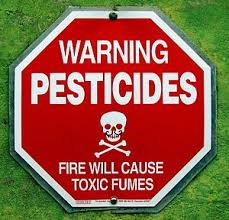 The EPA (Environmental Protection Agency) has failed the people of the United States with regard to pesticides and pesticide exposures, but absolutely given in to the wishes of the pesticide industry. This has resulted in pesticides being used in the US that are banned in other countries, and in Americans being exposed to unsafe pesticide exposures.
The EPA (Environmental Protection Agency) has failed the people of the United States with regard to pesticides and pesticide exposures, but absolutely given in to the wishes of the pesticide industry. This has resulted in pesticides being used in the US that are banned in other countries, and in Americans being exposed to unsafe pesticide exposures.
What is going on at the EPA? Cover-ups, studies finding health problems ignored, waiving of tests/studies that should have been done, political interference, pesticide industry lobbyists having a lot of influence at the EPA, punishment of scientists who speak out or point out harms about specific pesticides, top EPA officials leaving the EPA to work at pesticide companies, and on and on.
Yes, commonly used pesticides such as chlorpyrifos, Roundup, malathion, and neonicotinoids (neonics) all have had EPA suppression of research showing serious health harms (e.g. cancer, neurological harm).
Sharon Lerner at the Intercept has written a great piece of investigative journalism about pesticides and the EPA. She writes that the EPA:
“...is often unable to stand up to the intense pressures from powerful agrochemical companies, which spend tens of millions of dollars on lobbying each year and employ many former EPA scientists once they leave the agency. The enormous corporate influence has weakened and, in some cases, shut down the meaningful regulation of pesticides in the U.S. and left the country’s residents exposed to levels of dangerous chemicals not tolerated in many other nations.”
From the Intercept: The Department of Yes - How Pesticide Companies Corrupted the EPA and Poisoned America
While it’s impossible to catalog all the ways in which the EPA has failed to protect the public from the harms of pesticides, this reporting has brought to light several instances in which the overlooking, burying, or scuttling of science has had direct consequences for human health.
The alarming discoveries include an EPA report warning about the link between the pesticide glyphosate and cancer that never saw the light of day; the failure to consider evidence that a neonicotinoid pesticide causes brain damage; the refusal to investigate evidence that another pesticide that is an ingredient in Roundup may cause cancer; the dismissal of science showing that the widely used pesticide malathion causes cancer; and the agency’s waiving of the vast majority of toxicity tests at the request of industry.
The scientists who have identified these hazards described immense pressure from within the agency to overlook the risks they found. And several said they faced retribution for calling attention to the dangers of pesticides. “If you bring something up that’s an inconvenient truth, you get circumvented for any kind of committee work that you would need to have to get a promotion,” one toxicologist who used to work for the agency’s pesticide office told The Intercept. “It is the unwritten rule that to get promotions, all pesticides need to pass.”
Sometimes the urgency to approve pesticides comes from members of Congress, according to one EPA scientist. Within the pesticide office, staff refer to such cases as “yes packages,” said the scientist, who encountered the term on several occasions in which elected officials reached out to the EPA on behalf of companies whose pesticides were under review. “The companies will contact their local congressman or senator, and then we get what we call a congressional inquiry where they’ll contact our office directly and say, ‘Why is this taking so long?'”
Between 2000 and 2010, the EPA forced a mere four pesticides off the market, and in the past decade, only one. Meanwhile, agrochemical companies have introduced thousands of pesticides. The EPA now manages more than 16,800 pesticide products and 1,200 active ingredients.
As the number of pesticides in use was exploding, knowledge of their harms was also increasing, with pesticides being linked to a wide range of human health harms. Beyond the brain damage in children wrought by chlorpyrifos, the chemicals have been linked to various cancers, such as leukemia, brain cancer, breast cancer, and testicular cancer; liver, kidney, and lung damage; reproductive harms, including decreased fertility, spontaneous abortions, stillbirth, birth defects, premature birth, and low birth weight; deaths by poisoning; Parkinson’s disease; Alzheimer’s disease; kidney disease; heart disease; autoimmune conditions; and respiratory problems.
The U.S., once the beacon of hope for pesticide regulation, now lags behind. In 2016, the U.S. used 322 million pounds of pesticides that were banned elsewhere, according to a 2019 study by Nathan Donley, a biologist at the Center for Biological Diversity. Donley said that most of these chemicals had been banned for health and environmental reasons. At least 85 pesticides banned in China, Brazil, or the European Union were still used in the U.S. in 2016, he said, a number that has almost certainly increased since then.
The path from the EPA’s pesticide office to working in the pesticide industry is particularly well trodden. Since 1974, all seven of the office’s directors who continued to work after leaving the agency went on to make money from the pesticide companies they used to regulate, according to an analysis by The Intercept. (The two other former directors who left the agency went directly into retirement.)
